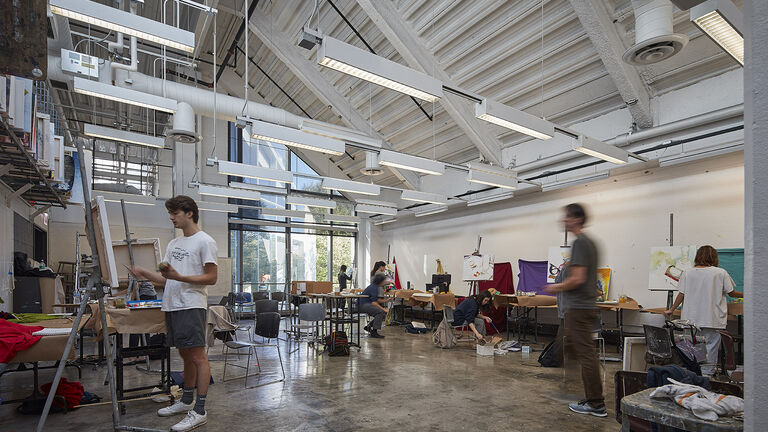
Chicago Studio
Chicago Studio
- Painting & Drawing OR
- Film, Video, New Media, & Animation
July 10- August 18, 2023
9:00 a.m – 4 p.m. CT
(6 Credits)
Space is limited due to our small 15-person class size.
Contact Lauren Hogan Casser at lhogan@saic.edu, or call us at 1.312.629.6100 during office hours (M–F 8:30 a.m. –4:30 p.m. Chicago time) with questions Please note: Students are required to live on campus during this program.
What better way to explore creative Chicago, expand your conceptual and technical art making, and sharpen your college-level writing skills than by drawing inspiration from our faculty and the resources of Chicago during our glorious summer season. ? These newly offered courses combine your First Year writing course with either a Painting and Drawing or Film, Video, New Media and Animation studio elective.=. This intimate and immersive experience allows you to familiarize yourself with our incredible urban campus and resources, spend your summer in Chicago, and get acclimated to campus before the start of the fall semester.
Course Information
-
Artists take notes – of the visual and verbal references which can act as catalysts for their artmaking. Every artist makes and thinks about their work differently, and our studio visits will introduce you to a variety of different approaches to bring back to your own work. Maybe you’ll discover a new process or material that intrigues you. Perhaps you are interested in the reference images or impressions from the physical space within the space. Or, you might be inspired by the subject matter being investigated by one of the artists we visit. During your studio visits, you will be taking notes, drawing in your sketchbooks, and be encouraged to take photos and images with your phone to refer to for your projects. We will also be reading short pieces authored by Langston Hughes, Twyla Tharp, Scott McCloud, Bernard Cooper, Margaret Atwood, G.K. Chesterton, Maya Lin, and Vincent van Gogh, among others.
Your faculty will work one-on-one with you to help you create your response pieces to the artists we visit. Expect to create a series of five to six pieces that thoughtfully explore the experience of visiting each artist’s studio piece. The course will culminate in a final critique of the works you produced over the summer.
You will also be producing short writing assignments and in-class journals, as well as writing and revising 3 main essays totaling 15-20 pages of formal prose. Similar to your studio experience, you will have one-on-one meetings with your faculty and informal interim critiques.
-
This summer intensive course is designed to introduce students to the language and histories of the moving image arts and the diverse ways in which artists have contributed to them using Chicago as inspiration.Throughout the semester we will examine a range of approaches to creating moving image work. We will compare and contrast established "norms" with radical and experimental approaches to these various media, leading to an understanding of the rich, complex, and evolving landscape upon which individuals have been making, and continue to make, moving image art.
Students will engage with this expanded field through lectures, readings, screenings, meetings with visiting artists as well as becoming active in discussions and practitioners in the field via group projects. Working in small groups, students will complete a series of short projects to introduce them to the various pathways of the department. By the end of the semester, students should have gain basic production and postproduction skills as well a good understanding of the key concepts relevant to contemporary film, video, new media, installation and animation.
Meet the Instructors
Asya Dubrovina (b. 1988 St. Petersburg Russia) is an artist working in moving image. Through film and installation, their works investigate the in-betweenness of place and memory. Asya collects stories and images to produce a wider social and historical perspective through a poetic lens. The observational point of view they use does not merely describe things as they are but offers questions and connections to that which lies outside the frame. Asya received a B.A. in Visual Studies and Moving Image from Keene State College in New Hampshire.